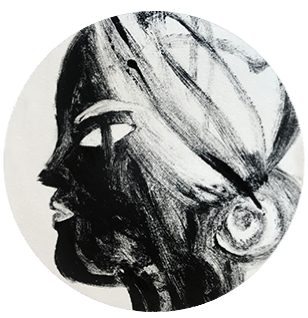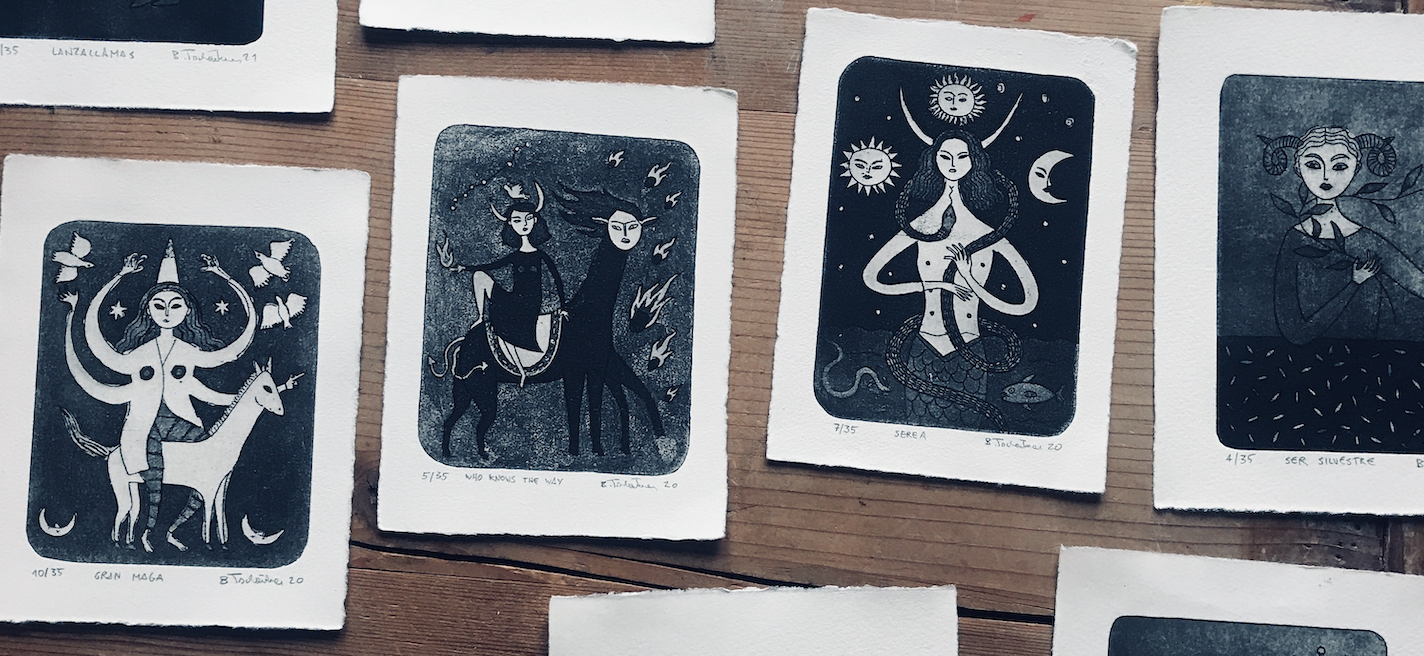The mariscadora has learned to speak the language of the sea early; her fingers have read thousands of shells, her hands have searched the unspeakable mud until they started to read signs in it. The mariscadora is a farmer, a farmer of the sea; she sows her fields and harvests them: her fruit are called almejas and berberechos..
Unlike the man, who proves himself against longitudes and latitudes, she is driven by curiosity – and curiosity is a form of love of life: She learns to read the moon and the tide; she reads the holes in the mud, she now knows where the shells hide; she bows under the sun, the whole day, her feet and her hands in the sea. Her body becomes the bridge between the land and the sea. She walks in the mud against an eternal, untouchable horizon. Often there is rain, and almost always there is wind. Treasure hunting is hard work.
The mariscadora is never alone, she is always surrounded by sisters who have arrived with the low tide. When her bucket is full, she helps to fill her sister’s. Mariscar – it’s a work that only can be done by hand, and is done best with lending each other a hand.
Where her man, navigating through the unknown, lets himself be guided by the stars, she turns into the moon. The sun and the wind draw lines and light in her face; the light and the salt make her what she is; a being of two worlds. During the day, she is the sister of the fish; tied to the rhythm of the tide, she only returns to the land when the sea rises: She has another garden there, high up on the rocks, where another kind of fruit grows.
And so she spends her days, always under the open sky – and what would be her brown eyes, if they didn’t turn blue like the ocean every day, and what would be her hair if she didn’t let the wind play with it?
Like the tide she’s moving back and forth between the land and the sea, a rhythm that finds an echo in the songs she sings, sometimes, when the wind blows goosebumps over her arms.
The songs she sings you don’t hear on the stages of this world and also not in the taverns on the island. They are songs without beginning and without end, songs that are call and response, the continuation of a rhythm that appeared somewhere, the tearing up of clouds or a gust of wind, the call of a bird, the leaping of a fish, the opening of a sea shell.
These are songs that belong to nobody, that belong only to themselves. Being an expression of the moment, they themselves become the moment, the becoming of a nameless sensation.
Songs that are picked up by the wind and carried out to the sea, far out, where they finally die away, already inaudible, and where sound mingles with light and water in myriads of particles. The wind carries the song away from the mariscadora, but nothing in nature is ever lost. Also the invisible, the intangible, the inaudible like the scattered song of the mariscadora writes itself into the big circuit; it gets dissolved, like everything else, in the swirls of the great song of the world.
It will reappear for us, that song, somewhen, in fragments, maybe in the first cry of a newborn on the island, or in a light, soft swell that wakes somebody who fell asleep in a boat in the port, and it will, without doubt, flashes up in the eyes of a young sailor far out on the sea who, for the first time after many weeks, in the first light of the sun, sees the coast again.
(I learned about the mariscadoras at the Illa de Arousa staying at La Platanera, the artist residency of Andrea Rodriguez, who comes from a family of mariscadoras)
The image below is a monotype I made inspired by the mariscadoras. You can watch a print reveal here.
The Mariscadora is available as fine art print.
Die Mariscadora
Die Mariscadora hat früh gelernt, die Sprache des Meeres zu sprechen. Tausende von Muschelschalen haben ihre Finger aufgelesen, bis sie sie lesen konnte, und sie hat den stummen Schlamm durchsucht, bis sie begann, die Zeichen in ihm zu verstehen.
Von ihrer Mutter und ihrer Großmutter hat sie gelernt, den Mond und die Gezeiten zu lesen, sie liest die winzigen Löcher im Schlamm, die keine Löcher sind, sondern Fenster, Münder, Augen, Kontaktstellen zu Außenwelt für die Muschel, die im Dunkel des Schlammes schläft und wächst und darauf wartet, oder vielleicht auch nicht, dass sie gepflückt wird von den Fingern der Mariscadora, die jetzt wissen, wo sich die Muscheln verstecken.
Die Mariscadora ist eine Bäuerin, eine Bäuerin des Meeres. Der Strand ist ihr Feld, das sie bestellt, und die Früchte, die sie erntet, heißen Almeja und Berberecho, Venusmuschel und Herzmuschel. Anders als ihr Mann, der sich jede Nacht selbst beweist, indem er sich mit Längengraden und Breitengraden anlegt, ist sie von Neugier getrieben, und Neugier ist eine Form der Lebenslust, eine Form der Liebe zum Leben.
Das Feld am Meer kennt keine Jahreszeiten, nur Gezeiten. Sobald Ebbe herrscht, erscheint, wie ein Naturgesetz, die Mariscadora, mit ihren hohen Stiefeln, Eimer und Rechen in der Hand. Den ganzen Tag arbeitet sie gebeugt unter der Sonne, Regen und Wind, das Wetter im Rücken, die Füße und Hände im kalten Wasser. Schatzsuchen ist harte Arbeit.
Ihr gebogener Körper wird zur Brücke zwischen Land und Meer. Bis das Wasser wieder ansteigt, geht sie im Schlamm, einem endlosen, unberührbaren Horizont entgegen, sie gehört zum Bild der galicischen Küste wie die Möwen und die Felsen und die duftenden Wälder, die direkt am Wasser beginning.
Die Mariscadora ist nie allein, sie ist immer umgeben von ihren Schwestern, die mit der Ebbe gekommen sind. Wenn ihr Eimer voll ist, hilft sie ihrer Schwester, deren Eimer zu füllen. Mariscar – eine Arbeit, die nur von Hand durchgeführt werden kann, wird am besten Hand in Hand erledigt.
Wo ihr Mann sich beim Navigieren durch die Unbekannte von den Sternen leiten lässt, wird sie zum Mond. Die Sonne und der Wind zeichnen Linien und Leuchten in ihr Gesicht, das Licht und das Salz machen sie zu dem, was ihre Bestimmung ist, ein Wesen zwischen zwei Welten. Während des Tages ist sie die Schwester der Fische. Gebunden an den Rhythmus der Gezeiten, kehrt sie nur aufs Land zurück, wenn das Meer ansteigt. Dort, oben auf den Felsen, hat sie einen anderen Garten, wo andere Früchte wachsen.
So verbringt sie ihre Tage, immer unter dem freien Himmel – was wäre ihre braunen Augen, wenn sie nicht jeden Tag blau wie das Meer werden würden, was wäre ihr Haar, wenn sie nicht den Wind darin spielen ließe?
Wie Ebbe und Flut bewegt sie sich hin und her über die Grenze zwischen Land und Meer, ein Rhythmus, der ein Echo findet in den Liedern, die sie singt, manchmal, wenn der Wind Gänsehaut über ihre Arme streift. Es sind Lieder, die man nicht hört auf den Bühnen dieser Welt und auch nicht in den Tavernen der Inseln.
Es sind Lieder ohne Beginn und ohne Ende, Lieder, die Ruf sind und Antwort, die Fortsetzung eines Rhythmus in der Umgebung, das Aufreißen von Wolken oder ein Windstoß, der Ruf eines Vogels, das Schnellen eines Fisches, das Aufgehen einer Muschel.
Es sind Lieder, die niemandem gehören außer sich selbst, ein Ausdruck des Moments sind, die selber der Moment werden, die Werdung einer namenlosen Empfindung.
Lieder, die der Wind aufnimmt und hinaus aufs Meer trägt, weit nach draußen wo sie endgültig ausklingen, unhörbar schon, und wo sich der Klang mit Licht und Wasser vermischt in Myriaden von Partikeln.
Der Wind trägt den Gesang fort von der Mariscadora, aber nichts in der Natur geht je verloren, auch Unsichtbares, Ungreifbares, Unhörbares wie das verwehte Lied der Mariscadora fügt sich ein in den großen Kreislauf, wird aufgelöst wie alles andere in den Wirbeln des Großen Ganzen, das große Lied der Welt.
Es wird wieder auftauchen für uns, das Lied, irgendwann, in Fragmenten, vielleicht im ersten Schrei eines Neugeborenen auf der Insel, oder in einem sanften Wellengang, der jemanden weckt, der am späten Nachmittag in einem Boot im Hafen eingeschlafen ist, und es wird, ohne Zweifel, eines Tages Aufblitzen im Auge eines jungen Seemanns draußen auf dem Meer, der im ersten Licht der Sonne die Küste zum ersten Mal nach vielen Wochen wiedersieht.




